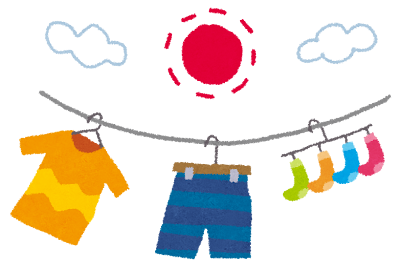The English translation is below
先日もSNSで、気づきを与えてくれる指摘がございました
英語ではwear1語で済むのに、日本語は身につける動詞が
かぶるだの履くだのたくさんありすぎる、と。
え、そうなの?多いの?というのが正直な感想でした
それぞれ動作が違うから、その動きにふさわしい動詞を
使ってるだけで、何の疑問も感じたことはなかったですから…
でも考えれば考えるほど、英語のwear/put onの万能ぶりが
まぶしく覚えてくるのです!
以下に挙げたアイテムは、日本語だといろいろと動詞が
変わるのですが、英語だと全部wear/put onでカバー
できてしまうんですね
頭:帽子/ヘルメット→かぶる
メガネ→かける
マスク/イヤリング→つける★
首元:ネクタイ→締める★
マフラー/スカーフ→巻く★
手・腕:時計/ブレスレット→つける★
指輪→はめる★
上半身:Tシャツ/ブラウス/ジャケット/コート→全部「着る」でOK
下半身:スカート/ズボン/靴/靴下→これも全部「履く」
。。。となります。確かに英語圏の皆さんが嘆くのも
ムリはありません、wear/put onは魔法のような単語です

なんとか学習者さんの負担を減らさなければなりません
それに、私たち日本人も細かい使い分けをせずに
できるところは別の簡単な言い換えで済ませるんですよ
上のアイテムで、★印のついたものは、「する」で言い換えられるます!
マスクをする、ピアスをする、マフラーをする、時計をする。。。
日常に必要ない物、アクセサリーなんかはコレで代用可能!
ただ…やはり基本の、かぶる、かける、着る、履く、は覚えて
いただかないと…服や装飾品の動詞をアイテムごとに分けるのは
日本語の特徴の一つですから。。。

でも言語って、結局お互い様だと思うんです
日本人にしたら「焼く」という1つの言葉が、英語だと
grill /broil /roast /toast /sear /fry /brown /bake。。。
この細かさは何なんだ〜このこだわりは何なんだ〜〜
という気分です。
文化によって、こだわりポイントが違っていて
こだわりが強いエリアは表現が豊富になるんですかね〜?
P.S いつもコメントありがとう!
毎回興味深い内容で、外から見た日本語の切り口に
日々深く考えさせられているよ〜♪
The other day on social media, someone pointed out something that really made me think. In English, you can cover it all with just one word, wear. But in Japanese, there are so many different verbs depending on what you put on—like kaburu for hats, haku for shoes, and more.
Honestly, my first reaction was, “Really? Are there that many?” After all, each verb in Japanese simply matches the action it describes—so I never questioned it. But the more I think about it, the more I realize how dazzlingly versatile wear and put on are in English!
The items listed below all take different verbs in Japanese. But in English, you can cover them all with just wear or put on.
head
- hat /helmet→かぶる
- glasses→ かける
- mask / earrings→ つける ★
around the neck
- necktie / tie→ 締める ★
- scarf→ 巻く ★
Hand/arm
- watch / bracelet→ つける ★
- ring→ はめる ★
- Upper body: T-shirts / blouses / jackets / coats → 着る
- Lower body: skirts / pants / shoes / socks → 履く
When it comes to clothing, Japanese uses “きる” for the upper body and “はく” for the lower body.
No wonder English speakers are baffled — “wear” and “put on” are almost magical verbs
Somehow we need to ease the burden on learners. After all, even we Japanese don’t always bother with the fine distinctions—where we can, we simply use an easier substitute.
In the list above, the items marked with ★ can all be replaced with the catch-all verb suru (“to do”). For example: masuku o suru (to wear a mask), piasu o suru (to wear earrings), mafuraa o suru (to wear a scarf), tokei o suru (to wear a watch)… For accessories and other non-essential items, this works perfectly!
That said, learners still need to master the basics—kaburu (for hats), kakeru (for glasses), kiru (for clothes), haku (for shoes). This way of dividing verbs by item is, after all, one of the unique features of Japanese.
But in the end, I think languages are all about give and take. For Japanese speakers, the single verb yaku (“to cook with heat”) suddenly branches out into grill, broil, roast, toast, sear, fry, brown, bake… and we’re left wondering, “Why so many? Why so picky?!”
It makes me think that every culture has its own areas of obsession. And wherever that obsession runs deep, the language naturally develops a rich variety of expressions.


